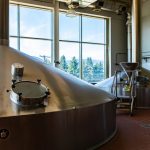Pilsner beer, often spelled as “Pilsner,” is a style of pale lager that originated in the Czech city of Pilsen. It’s one of the most popular and widely consumed styles of beer globally, renowned for its crispness, refreshing qualities, and a distinctive hop bitterness. The birth of Pilsner beer in the mid-19th century marked a significant moment in brewing history, influencing the development of countless lager styles.
Historical Origins
The story of Pilsner beer begins in 1842 in the city of Pilsen, located in what is now the Czech Republic. Dissatisfied with the quality of the local beers, the citizens of Pilsen decided to establish a new brewery and appointed a Bavarian brewer named Josef Groll to lead the endeavor.
Groll introduced several innovations to brewing, including the use of pale malts, Saaz hops, and the newly available soft water from Pilsen’s artesian wells. He also employed bottom-fermenting lager yeast and, most notably, pioneered a new method of lagering or cold storage. This combination of factors resulted in a revolutionary beer that was pale, clear, and had a crisp, refreshing taste. The beer was named Pilsner, after the city of its origin.
Key Characteristics of Pilsner Beer
- Appearance:
- Pilsners are known for their brilliant clarity and a pale, straw to golden color. The beer’s appearance is a testament to the use of pale malts and the lagering process that promotes clarity.
- Flavor Profile:
- Pilsner beers typically have a clean, crisp taste with a noticeable hop bitterness. The use of Saaz hops, known for their mild and floral characteristics, imparts a delicate yet distinct hop flavor. The malt sweetness is balanced by the bitterness, resulting in a well-rounded profile.
- Aroma:
- The aroma of a Pilsner is often characterized by a mild, grainy maltiness and a subtle hop fragrance. The hop aroma is usually not as pronounced as in some other hop-forward styles but contributes to the overall balance.
- Carbonation and Mouthfeel:
- Pilsners are effervescent and highly carbonated, contributing to their refreshing nature. The mouthfeel is typically light and crisp, making them easy-drinking beers.
- Lagering Process:
- One of the defining features of Pilsner beer is the lagering process. After fermentation, Pilsners are stored at cool temperatures for an extended period, allowing the flavors to mellow and the beer to clarify. This cold conditioning contributes to the beer’s smoothness and drinkability.
Variations of Pilsner
While the original Pilsner from Pilsen set the standard, variations of the style have emerged over the years, each with its unique characteristics:
- German Pilsner (Pils):
- German Pilsners, often referred to simply as “Pils,” share similarities with the Czech original but may have a slightly more prominent hop bitterness. They showcase a clean, malt profile and a notable hop aroma.
- American Pilsner:
- American craft brewers have put their own spin on the Pilsner style. American Pilsners often feature a more pronounced hop presence, with some brewers incorporating American hop varieties, resulting in a bolder hop flavor and aroma.
- Bohemian Pilsner:
- Staying true to the Czech tradition, Bohemian Pilsners prioritize a balance between malt sweetness and Saaz hop bitterness. They tend to have a slightly richer malt character compared to their German counterparts.
- International Pilsner:
- As the popularity of Pilsner spread globally, breweries around the world started brewing their interpretations. International Pilsners may incorporate local ingredients and brewing techniques while adhering to the general characteristics of the style.
Modern Craft Pilsners
In recent years, there has been a resurgence of interest in traditional beer styles, including Pilsner, within the craft beer movement. Craft brewers, known for their innovation, have embraced the challenge of brewing high-quality Pilsners with a focus on top-notch ingredients and precise brewing techniques.
Craft Pilsners often showcase a commitment to quality malt, hops, and yeast, with some brewers experimenting with different hop varieties and even barrel aging. The goal is to create a Pilsner that honors the classic characteristics of the style while offering a unique and modern twist.
Pilsner beer’s legacy extends far beyond the cobblestone streets of Pilsen. Its creation marked a turning point in brewing history, giving rise to a style that would become a global favorite. From the crisp, golden lagers of Germany to the hop-forward interpretations in the United States, Pilsner has demonstrated its versatility while maintaining a core set of characteristics that define its identity.
Whether enjoyed on a hot summer day or sipped year-round, the appeal of Pilsner lies in its simplicity, balance, and refreshing nature. As brewers continue to innovate and beer enthusiasts explore new flavors, the legacy of Pilsner persists, and its influence on the world of beer remains as strong as ever.


Leave a Reply